Dell Studio XPS 16: the Eyes Have It
by Jarred Walton on April 2, 2009 6:00 PM EST- Posted in
- Laptops
Display Quality
The last area we want to test is the display quality. We have stated in the past that laptop LCDs pale in comparison to typical desktop LCDs, but the Studio XPS 16 tries to buck that trend. We've hinted that it succeeds, and here you can see the results of our testing.
We test color accuracy using ColorEyes Display Pro, and we test with two different colorimeters, a DTP-94 and an i1 Display2. We test the laptops with both colorimeters using ColorEyes Display Pro, generating both LUT and Matrix color profiles. The reason we do this is that some displays respond better to LUT profiling while others work better with Matrix profiling. We select the best result out of the four tests for our color accuracy charts.
Besides the color accuracy, the generated profiles allow us to determine color gamut, using GamutVision. We use the matrix color profiles for gamut, as they usually have ~10% higher gamut volume. We will also report the maximum LCD brightness and contrast ratio.

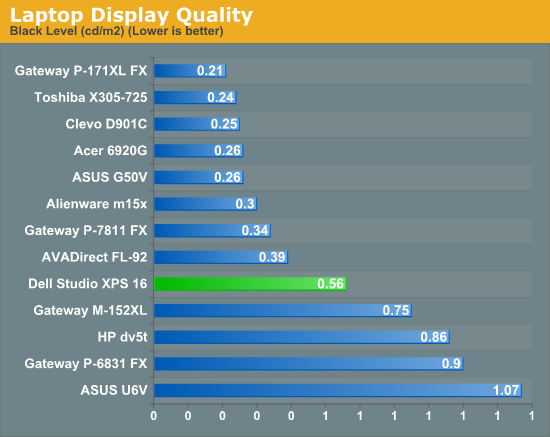
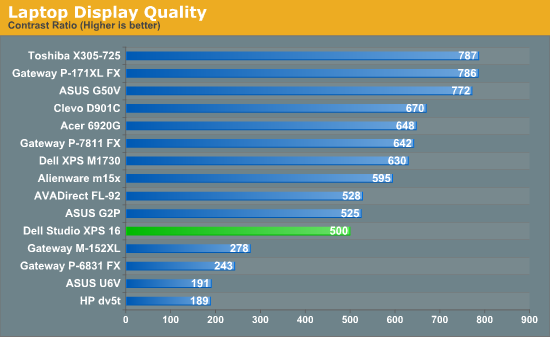
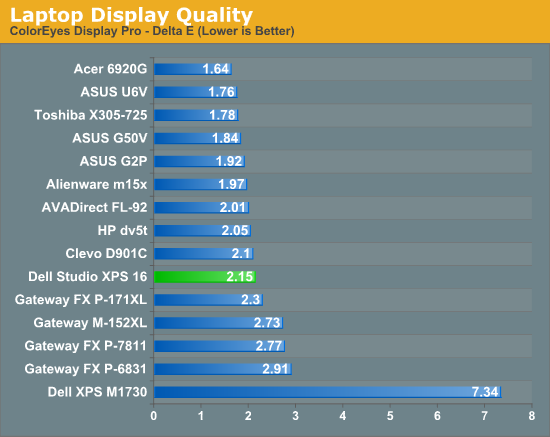
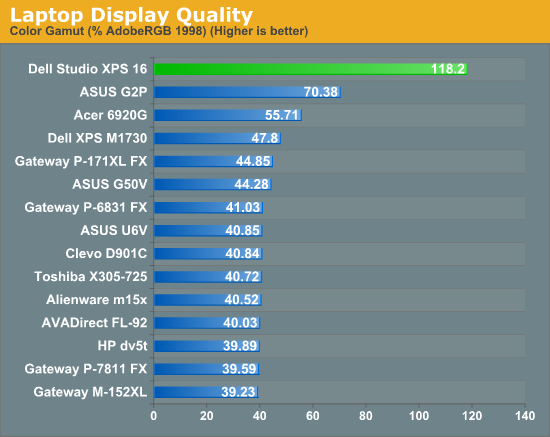
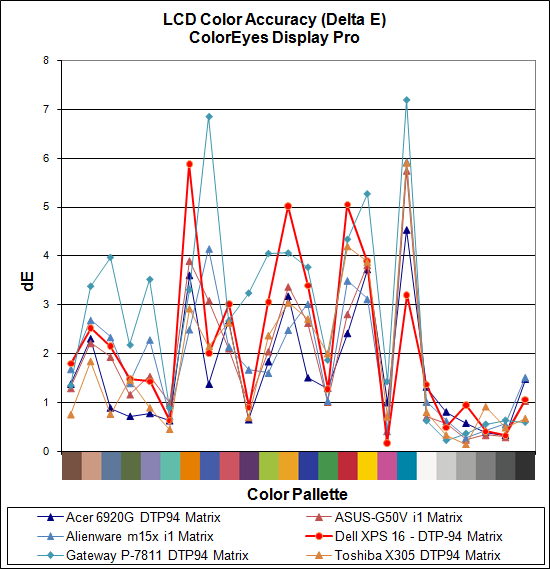
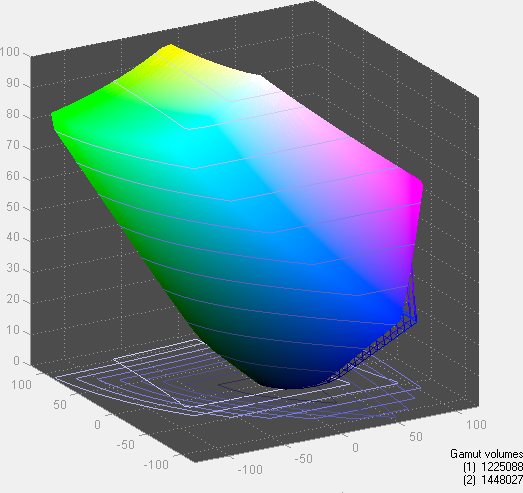
If you just scan over those graphs quickly, you might not be very impressed by the Studio XPS 16 LCD. Color accuracy is middle of the road, and contrast ratio and black levels are nothing special either. The maximum brightness is at the top of the charts, but again that's reflected with the higher than average black level. Here's the catch: contrast ratios above 500:1 are definitely a case of diminishing returns. It's very easy to look at something like the Gateway P-6831 and the Studio XPS 16 and see that the P-6831 has a poor contrast ratio. However, eyeballing the difference between the XPS 16 and any of the higher contrast ratios and determining which is "better" is far more difficult.
The big deal with the RGB LED backlighting is in the last chart. A color gamut of over 100%? In a laptop LCD? You can't be serious! Granted, we haven't tested every single laptop LCD out there, but the vast majority of laptops we've looked at have displays that can't even reach 50% color gamut. In fact, we haven't even tested a desktop LCD that has hit 118% (though Dell's 2480WFP came close and newer display have almost certainly surpassed that mark).
The ASUS G2P was one of my favorite laptops for a long time simply because of the LCD. The Acer 6920G impressed me by offering an image that was visibly better than other laptops, even though it couldn't compete with desktop LCDs. The RGB LED 1080p display on the Studio XPS 16 offers over twice the color gamut of the Acer 6920G. Again, there's a case of diminishing returns - anything beyond about 80% doesn't usually impact how you see colors unless you're really picky. However, this is the first laptop LCD to break the 80% barrier, let alone surpassing any desktop LCD that we've currently tested.
Even though the color gamut is much better than any other laptop we've tested, we do need to contain our enthusiasm somewhat. At its heart, this is still a TN panel, which means the overall quality can't match PVA, MVA, or IPS panels. Dell - or Seiko Epson if you prefer, as they're the panel manufacturer - has taken the first step by offering an improved color gamut on a laptop display. We're still a little baffled as to why no one seems to be interested in making new PVA or IPS laptop panels, as the combination of a high gamut backlight with an IPS panel would be ideal. This is still a great display, but when I want to do some serious image editing I'm still going back to my S-IPS desktop LCD.










79 Comments
View All Comments
Nfarce - Friday, April 3, 2009 - link
I have a 3 year old 17" Inspiron E1705 and still love it. When new, it played older DX9 games like Return to Castle Wolfenstein pretty well with a 2.0GHz Centrino and ATi X1400.It has the glossy screen which really helps increase the contrast appearance and really doesn't affect me because I don't use the laptop outside or next to a window. Yes, fingerprints and smudges are an issue even being as careful as possible. However, it's a small price to pay for a better picture IMO. I just don't like the "matte" screen on my Sammy 22" LCD on a gaming rig - and I think that is even harder to clean and get smudges off. Something about the grooves or something in the cover.
Finally, what's up with all these new weird LCD screen sizes these days? I use a 15.4" laptop for work and it's just too small by itself when not connected to a docking station with a monitor. And then we have the new 23" LCDs out now, and the 25.5" LCDs...
Digobick - Friday, April 3, 2009 - link
Is the 9-cell battery removable (meaning, can you take it off if you don't think you'll need it)?Also, have you weighed the laptop with the 9-cell battery installed? I'm curious to know how much it weighs with both the 9- and 6-cell batteries installed.
JarredWalton - Friday, April 3, 2009 - link
The 9-cell battery weighs a bit more than the 6-cell, probably .2 or .3 pounds. I don't have a scale that can measure such weights accurately, unfortunately, so I use the manufacturer specifications.As for the first question, the 9-cell battery is a replacement for the 6-cell; you can only use one or the other. The 9-cell is larger and raises the back of the laptop, with a .5 to 1 inch protrusion on the bottom where the 6-cell battery is flat.
andrezunido - Friday, April 3, 2009 - link
Would it be possible to have the figures for the macbook pro 15'' color gamut to compare with the Dell XPS 16?jabber - Friday, April 3, 2009 - link
You could at least have wiped the laptop down before taking the pics!That just looks sloppy. Yo did get a cloth after all.
Unless of course it was a scratched/battered review model.
JarredWalton - Friday, April 3, 2009 - link
Actually, it isn't messy at all and those aren't scratches... at least not on the laptop. That's just a reflection of the white paper I have around my photography area. The laptop surface is extremely reflective, so I'm happy it's just reflecting paper and not my face, camera, etc.jabber - Friday, April 3, 2009 - link
Hmmmmmmm still looks like the blue haze of greasy fingerprints round the edges.Just doesnt look right to me.
Please can we ditch glossy plastics now?
ksherman - Friday, April 3, 2009 - link
Apple stopped offering the choice on the MacBook Pro (and now indeed all their current computers/displays) back in November. It SUCKS. At least its a sheet of glass (supposedly) not a glossy coating.Pirks - Friday, April 3, 2009 - link
ksherman, check your facts before posting please. This is from www.apple.com online store:MacBook Pro comes with a high-resolution 1920x1200 pixel LED-backlit display. Choose a standard glossy display that lets you view graphics, photos, and videos with richer color and deeper blacks, or an optional antiglare display.
MacBook Pro 17-inch Hi-Resolution Glossy Widescreen Display
MacBook Pro 17-inch Hi-Resolution Antiglare Widescreen Display [Add $50.00]
See, Apple still offers antigare option no matter what you say.
erple2 - Tuesday, April 7, 2009 - link
Both of you are simultaneously right and wrong. The 17" Macbook Pro can be had with a either a glossy or non-glossy screen. The 15" Macbook Pro comes only with a glossy screen.